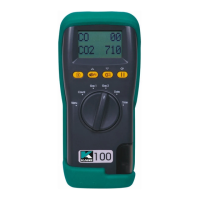
Do you have a question about the Kane 100-1 and is the answer not in the manual?
| Brand | Kane |
|---|---|
| Model | 100-1 |
| Category | Measuring Instruments |
| Language | English |
Details on using Kane trickle and fast chargers for battery charging, including charging times.
Instructions for setting the correct time and date after calibration and switch on.
Procedures for emptying the water trap and changing the particle filter.
Verify date, time, battery power, and zeroing; avoid temperature changes and radio interference.
Procedure to switch on the unit, calibrate sensors, and set CO/CO2 zero offsets.
How to switch off the analyser, including the countdown for sensor cleaning.
Using UP/DOWN/ENTER keys for display options and settings changes.
Using the ENTER key to hold readings for printing or save readings to memory.
Procedure to switch the backlight on or off using the PRINT/BACKLIGHT button.
How to start analyser printing and printer setup requirements.
Instructions for switching the pump on and off during operation.
Using HOLD/ENTER to freeze readings for printing or live measurements.
Overview of rotary dial positions: Menu, Count, Gas 1, Gas 2, Date, Time.
Setting time, date, date format, and language options within the menu.
Adjusting pump speed (full/quiet) and display contrast.
Performing fresh air or true zero calibration using menu options.
Configuring alarm points and accessing protected service functions.
Guide to navigating menu, changing settings, and exiting functions.
Navigating and viewing stored readings using the VIEW function.
Options for logging data, printing stored sets, and exiting view mode.
How to initiate and manage AUTOSTORE, including setting store intervals.
Tips for maximizing stored readings and battery life during autostore.
How to perform a summary print showing max, min, and average readings.
Procedure to clear all stored data using the CLEAR function.
Toggling pump speed between Full Speed and Quiet mode.
Steps to perform fresh air or true zeroing, including adjusting fresh air values.
Altering alarm points for CO and CO2, and setting preset alarm levels.
Methods for taking ambient air measurements with or without a probe/hose.
Key precautions: temperature limits, filter condition, magnetic boot, probe care.
Recommendation to check and re-zero CO and CO2 in fresh air before tests.
Example of a standard instant printout showing CO and CO2 readings.
Example of a manually logged printout via stored data.
Example of a summary printout of autologged data including max/min/avg readings.
Instructions for switching off the analyser in fresh air for sensor maintenance.
Table of fault symptoms like battery issues or analyser response, with their causes and solutions.
Steps to resolve issues when the analyser stops logging, e.g., full memory, pump off.
Steps to fix a blank/dark display or a frozen display with continuous beeping.
Advice on what to do if the unit fails to turn off correctly.
Recommendation for annual recalibration and service to prevent drift and damage.
How to select service mode and warnings about using incorrect codes.
Details on resolution, accuracy, and specified/over ranges for CO and CO2.
Specifications for dimensions, weight, ambient operating range, and battery life.
Input and output specifications for the standard type trickle charger.
Information on EMC compliance and advice on checking for electromagnetic interference.
Details of generic standards (EN 61000-6-3, EN 61000-6-1) the product complies with.
WHO recommended maximum exposure levels for Carbon Monoxide at different durations.
Occupational exposure limits for CO2 from HSE, BSRIA, and ASHRAE.
Information sources for ambient CO2 data from NOAA observatory.
